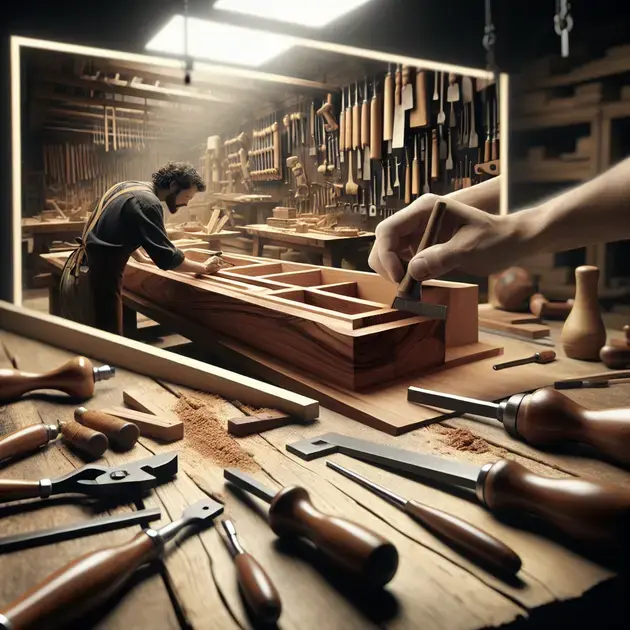Are you ready to dive into the world of woodworking and learn how to craft masterpieces with your own hands? In this comprehensive guide, we will walk you through everything you need to know to become a woodworking pro. From selecting the right wood materials to mastering essential techniques, this guide will help you unleash your creativity and woodworking skills.
Woodworking is not only a timeless craft with a rich history, but it has also experienced a resurgence in popularity in recent years. With more people turning to woodworking as a way to unwind and create unique pieces, there has never been a better time to start your woodworking journey. Whether you are a beginner looking to build your first project or an experienced woodworker seeking new challenges, this guide is designed to inspire and educate woodworkers of all levels.

**Crafting Masterpieces: The Art of Wood Selection**
Wood Selection and its Impact on Your Project
Choosing the right type of wood is crucial when it comes to crafting masterpieces in woodworking. Different wood species have varying characteristics such as grain pattern, color, hardness, and durability. To start, it’s essential to research and understand the properties of the wood species you’re considering for your project. Websites like Wood Database provide detailed information on various types of wood, including their strengths and weaknesses.
Once you have narrowed down your options, the next step is to visit a local lumberyard or specialty wood store to physically inspect the wood. Look for straight boards with minimal knots and imperfections for a cleaner and more professional finish. Additionally, consider the structural requirements of your project and choose a wood species that can withstand the intended use.
Remember that the wood’s appearance will also play a significant role in the overall aesthetics of your masterpiece. Some woods, like walnut or cherry, have rich colors and pronounced grain patterns that can enhance the visual appeal of your project. Experimenting with different wood combinations can also add a unique touch to your woodworking creations.
By carefully selecting the right type of wood for your project, you can ensure that your craftsmanship shines through in every detail. Paying attention to the art of wood selection will set the foundation for creating truly remarkable woodworking masterpieces.
Understanding Woodworking Techniques and Best Practices
Mastering essential woodworking techniques is key to achieving success in your projects. Whether you’re a beginner or an experienced woodworker, continuously honing your skills and knowledge is crucial for creating high-quality pieces. Websites like Popular Woodworking offer a wealth of resources, including tutorials, tips, and tricks to help you improve your woodworking skills.
Start by familiarizing yourself with fundamental techniques such as measuring and cutting wood accurately, joining pieces effectively, and finishing surfaces smoothly. Practice these skills on small projects before tackling more intricate designs to build your confidence and expertise.
Investing in quality woodworking tools and equipment is also essential for achieving professional results. Websites like Woodcraft provide a wide range of tools for both beginners and seasoned woodworkers. Proper tool maintenance and sharpening are equally important in ensuring that your tools perform optimally and produce precise cuts.
Additionally, learning about different types of joinery techniques, such as dovetail joints or mortise and tenon joints, can elevate the strength and durability of your woodworking projects. Experimenting with various techniques and exploring new methods will broaden your skill set and enhance the quality of your craftsmanship.
By mastering essential woodworking techniques and adopting best practices, you can elevate your woodworking skills to new heights and create masterpieces that showcase your talent and dedication to the craft.
Fostering Creativity and Innovation in Woodworking Projects
Unleashing your creativity in woodworking allows you to explore new design ideas and push the boundaries of traditional woodworking techniques. Embracing innovation in your projects can lead to stunning and unique masterpieces that reflect your artistic vision. Websites like Fine Woodworking offer inspiration and ideas from renowned woodworkers to spark your creativity.
Start by experimenting with different wood species, finishes, and textures to create visually captivating pieces that stand out. Incorporating unconventional elements such as metal accents or intricate inlays can add a contemporary twist to your traditional woodworking projects.
Consider exploring new woodworking styles and aesthetics, such as mid-century modern or Scandinavian design, to infuse fresh perspectives into your work. Drawing inspiration from nature, architecture, and other art forms can also fuel your creativity and inspire innovative woodworking creations.
Collaborating with other woodworkers, attending woodworking workshops, or joining online woodworking communities can provide a supportive environment for sharing ideas and receiving feedback on your projects. Engaging with a community of like-minded individuals can stimulate your creativity and motivate you to explore new techniques and approaches in woodworking.
By unleashing your creativity and embracing innovation in woodworking, you can transform your projects into true works of art that captivate and inspire others. Let your imagination soar and see where it takes your woodworking journey.

Choosing the Right Tools for Woodworking Mastery
When it comes to woodworking, having the right tools is essential for achieving mastery in the craft. Whether you are a beginner or a seasoned woodworker, investing in high-quality tools can make a significant difference in the outcome of your projects. One of the key tools that every woodworking enthusiast should have is a reliable set of chisels. Chisels come in various sizes and shapes, allowing you to make precise cuts and create intricate details in your woodworking pieces.
Another essential tool for woodworking mastery is a good quality hand plane. Hand planes are versatile tools that can be used for shaping, smoothing, and flattening wood surfaces. They are indispensable for achieving a professional finish on your projects. Additionally, having a set of high-quality saws in your toolkit is crucial for making accurate and clean cuts. From hand saws to power saws, there are different types of saws available to suit various woodworking tasks.
Furthermore, investing in measuring and marking tools such as tape measures, squares, and marking knives is vital for ensuring precision in your woodworking projects. Accurate measurements and markings are crucial for creating well-fitted joints and flawless finishes. Lastly, having a reliable workbench equipped with clamps and vises is essential for providing stability and support while working on your woodworking projects.
In conclusion, choosing the right tools for woodworking mastery is a significant step towards enhancing your craftsmanship. By investing in high-quality tools such as chisels, hand planes, saws, measuring tools, and a sturdy workbench, you can elevate your woodworking projects to the next level and create masterful pieces that showcase your skills and creativity.
Exploring Advanced Joinery Techniques
Mastering advanced joinery techniques is a crucial aspect of woodworking craftsmanship that sets experienced woodworkers apart. Joinery refers to the method of joining two pieces of wood together to create strong and durable connections. By exploring advanced joinery techniques, woodworkers can elevate the quality and complexity of their projects, resulting in finely crafted pieces that exhibit precision and attention to detail.
One of the advanced joinery techniques commonly used in woodworking is the dovetail joint. Dovetail joints are known for their strength and aesthetic appeal, making them popular choices for connecting drawers, boxes, and cabinet corners. By mastering the art of creating tight-fitting dovetail joints, woodworkers can enhance the structural integrity and visual appeal of their projects.
Another advanced joinery technique worth exploring is the mortise and tenon joint. This traditional jointing method is versatile and can be used in various woodworking applications, including constructing tables, chairs, and doors. By understanding the principles of creating mortise and tenon joints, woodworkers can achieve strong and durable connections that withstand the test of time.
Furthermore, experimenting with complex joinery techniques such as the finger joint, box joint, and spline joint can add decorative elements and structural reinforcement to woodworking projects. These advanced joinery techniques require precision and skill to execute effectively, showcasing the woodworker’s expertise and craftsmanship.
In summary, exploring advanced joinery techniques in woodworking opens up a world of possibilities for creating intricate and finely crafted pieces. By mastering techniques like dovetail joints, mortise and tenon joints, and other advanced joinery methods, woodworkers can enhance the strength, durability, and visual appeal of their projects, taking their craftsmanship to new heights.
The Importance of Finishing Touches in Woodworking Craftsmanship
While selecting the right tools and mastering advanced joinery techniques are essential aspects of woodworking, the finishing touches play a crucial role in elevating the craftsmanship of a woodworking project. Finishing touches refer to the final steps taken to enhance the appearance, texture, and durability of the wood surfaces, transforming them from raw materials into polished, professional-looking pieces.
One of the key finishing touches in woodworking craftsmanship is the application of wood finishes such as stains, varnishes, and oils. Wood finishes not only protect the wood from moisture and wear but also enhance its natural beauty by highlighting the grain patterns and colors. By choosing the right wood finish and applying it skillfully, woodworkers can achieve a flawless and long-lasting finish that enhances the overall appearance of their projects.
Sanding is another critical finishing touch that can significantly impact the final look and feel of a woodworking piece. Proper sanding techniques ensure that the wood surfaces are smooth, free of imperfections, and ready for finishing. By starting with coarse-grit sandpaper and gradually progressing to finer grits, woodworkers can achieve a silky-smooth finish that is ready for staining or painting.
Additionally, paying attention to details such as edge profiles, chamfers, and decorative carvings can add a touch of elegance and sophistication to woodworking projects. These small yet significant finishing touches can take a piece from functional to exquisite, showcasing the woodworker’s dedication to craftsmanship and attention to detail.
In conclusion, the importance of finishing touches in woodworking craftsmanship should not be underestimated. By applying wood finishes, mastering sanding techniques, and adding decorative elements, woodworkers can elevate the quality and visual appeal of their projects, creating stunning pieces that reflect their skill, passion, and commitment to the craft.
Conclusion
Choosing the right tools is essential for woodworking mastery, whether you are a beginner or seasoned woodworker. Investing in high-quality tools such as chisels, hand planes, saws, measuring tools, and a sturdy workbench can elevate your craftsmanship and help create masterful pieces that showcase your skills and creativity.
Exploring advanced joinery techniques
Mastering advanced joinery techniques like dovetail joints and mortise and tenon joints can elevate the quality and complexity of woodworking projects, showcasing precision and attention to detail. Experimenting with complex joinery techniques adds decorative elements and structural reinforcement, highlighting the woodworker’s expertise and craftsmanship.
The importance of finishing touches
While selecting the right tools and mastering joinery techniques are crucial, the finishing touches are equally important in woodworking craftsmanship. Applying wood finishes, mastering sanding techniques, and paying attention to details like edge profiles and decorative carvings can enhance the quality and visual appeal of projects, reflecting the woodworker’s dedication and passion for the craft.